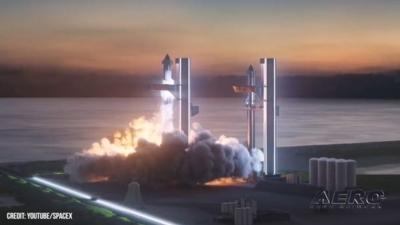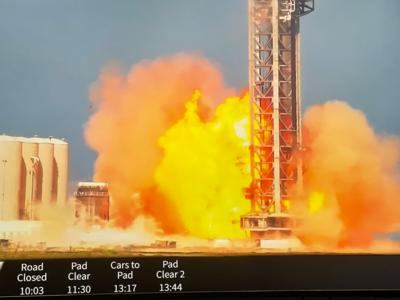Activists Predictably Indignant
Environmental nonprofits sued the Federal Aviation Administration on Monday, 01 May 2023, alleging as one that the agency violated the National Environmental Policy Act by allowing SpaceX to launch its Starship spacecraft, the largest rocket yet hurled spaceward by humankind, from the company’s Boca Chica, Texas Starbase facility.

According to court filings, the plaintiffs contend the FAA failed to undertake a “comprehensive environmental review” of the Starship launch.
The lawsuit was filed in Washington D.C. district court—naturally—by the Center for Biological Diversity, the American Bird Conservancy, SurfRider Foundation, Save Rio Grande Valley, and the Carrizo-Comecrudo Nation of Texas.
The quintet of plaintiffs argued the FAA ought have conducted an exhaustive Environmental Impact Statement (EIS) prior to allowing SpaceX to attempt the 20 April Starship launch from Boca Chica.
The groups set forth in their lawsuit: “The FAA failed to take the requisite hard look at the proposed project and has concluded that significant adverse effects will not occur due to purported mitigation measures.”
The plaintiffs argued the FAA waived more thorough analyses based on proposed “environmental mitigations,” contending such mitigations as the agency did actually require of SpaceX were woefully insufficient to offset environmental damages resultant of: launch events, the construction of launch infrastructure, increased ground traffic on and near SpaceX’s Starbase, and “anomalies” the likes of the destruction of the Starship launch pad and mid-air explosion of the spacecraft itself.
On 20 April 2023, the first orbital launch attempt of SpaceX’s Starship Super Heavy rocket resulted in extensive damage to the company’s launch pad and structures adjacent thereto. The tremendous thrust of Starship’s 33 first-stage Raptor engines—some 17,100,000-pounds—all but destroyed the pad, hurling chunks of concrete and rebar into what plaintiffs called the “sensitive habitat” surrounding the South Texas launch-site. Pulverized concrete, too, was mentioned in the lawsuit, as was a 3.5-acre brushfire and the fragmented wreckage of the Starship vehicle, which rained down across several square miles after the vessel was purposefully destroyed by SpaceX following a sequence of material, component, and systems failures which collectively occasioned an anomalous and uncorrectable flight condition.
The plaintiffs are seeking, also, to force the FAA to revoke the launch license it previously granted SpaceX and predicate the issuance of a new license upon the completion of an EIS.
In their complaint, attorneys representing the five plaintiffs noted the FAA’s own chief of staff for the Office of Commercial Space Transportation stated, in June 2020, that the agency was planning an EIS. The complaint goes on to allege that sometime later, “based on SpaceX’s preference,” the FAA waived the EIS, opting, instead, to conduct “a considerably less thorough analysis,” for purpose of allowing Starship to launch in short order.
Despite the destruction of the Starbase launch-pad, blasts of reinforced concrete, fire, and flurries of Starship debris, SpaceX CEO Elon Musk tweeted: “To the best of our knowledge there has not been any meaningful damage to the environment that we’re aware of.”
The actual impact of the Starship launch on the people, wildlife, and habitat of South Texas is currently being evaluated by federal and state agencies, environmental researchers, and SpaceX.

As of Wednesday, 26 April, researchers from the U.S. Fish and Wildlife Service had found not a single carcass of a single South Texas animal protected by the Endangered Species Act.
Access by tribes, researchers, and the public to the state parks, beaches, and the National Wildlife Refuge area in the vicinity of SpaceX’s Starbase facility are of particular concern to the groups suing the FAA.
Plaintiff’s attorneys—noting Boca Chica Beach had been closed or inaccessible for approximately 500 hours in 2021 on account of SpaceX launch activity—contend the rate of closure permitted by the FAA “infringes upon the ability of the Carrizo/Comecrudo Nation of Texas to access lands and waters that are part of their ancestral heritage.”
 Aero-News: Quote of the Day (12.11.25)
Aero-News: Quote of the Day (12.11.25) ANN's Daily Aero-Term (12.11.25): Nonradar Arrival
ANN's Daily Aero-Term (12.11.25): Nonradar Arrival Classic Aero-TV: David Uhl and the Lofty Art of Aircraft Portraiture
Classic Aero-TV: David Uhl and the Lofty Art of Aircraft Portraiture Airborne-NextGen 12.09.25: Amazon Crash, China Rocket Accident, UAV Black Hawk
Airborne-NextGen 12.09.25: Amazon Crash, China Rocket Accident, UAV Black Hawk Airborne 12.05.25: Thunderbird Ejects, Lost Air india 737, Dynon Update
Airborne 12.05.25: Thunderbird Ejects, Lost Air india 737, Dynon Update




